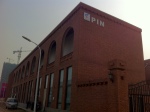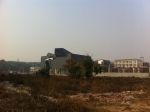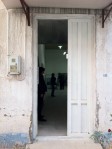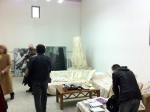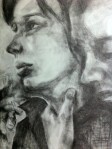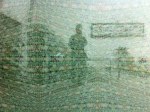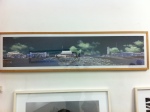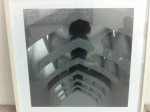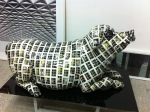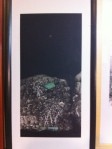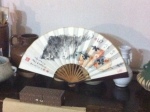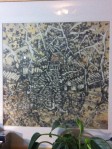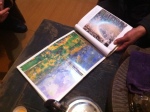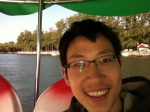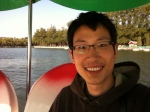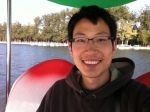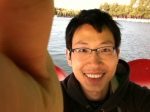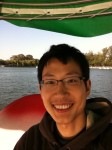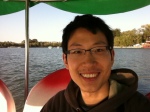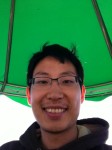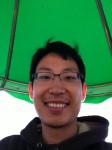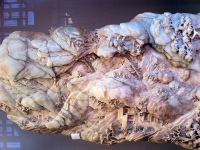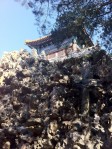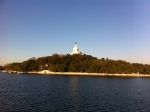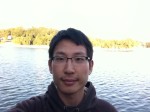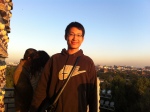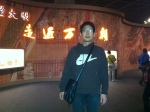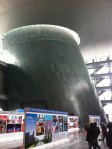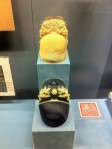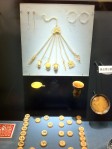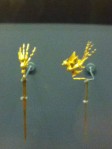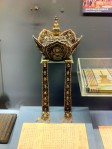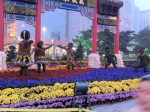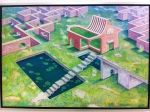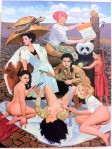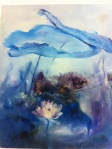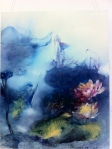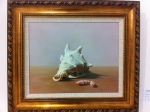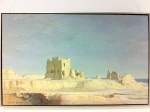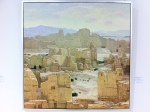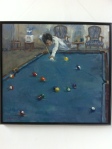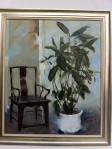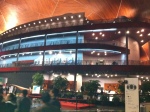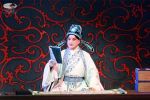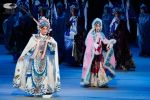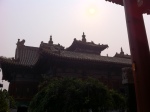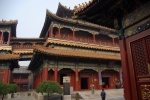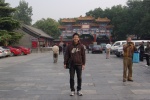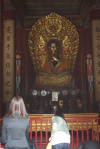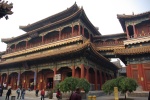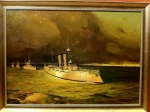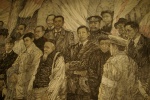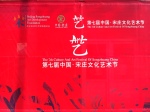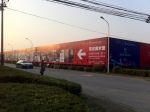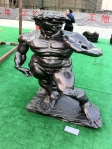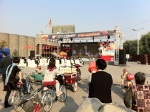
At the opening of the Gwangju Museum of Art Beijing artist residency exhibition. Myself pictured front row, fourth from left.
My group visited the studio of painter Li Guorui, the 798 Art District and attended the opening of the Gwangju Museum of Art Beijing residency artists’ exhibition.
Li Guorui had paintings of horses and boats and a larger painting of blue collar workers hung on one of the walls of his studio. I asked him through Mr. Zheng Xuewu why he painted the boats. Li Guorui responded through Mr. Kim Namo, a Beijing-based Korean artist who accompanied us, that ‘these boats he painted are of the old, neglected and disappearing ones in his hometown, which was a fishing village. He remembers seeing many of these boats as a child and is sad that they have disappeared. He painted the boats as a reminder that human beings, too become forgotten about when they grow old and weathered.’ I nodded. I also asked why the artist painted his horses, to which Mr. Kim Namo responded that the horses were commissioned by a buyer in Taiwan.
My group headed on to the 798 Art District, a bit of a ride from Songzhuang, where we arrived first at Mr. Kim Namo’s cafe and gallery and had lunch. The gallery is named 798 With Space and is where the opening of the exhition of Gwangju Museum of Art Beijing residency artists was to take place later in the afternoon. My group was joined by another group of artists from Gwangju, also sponsored by the Gwangju Museum of Art. A different group of four artists from Gwangju, and one Beijing-based artist, are each staying at the Gwangju Museum of Art’s studios in Beijing for one year (3 months in the case of the Beijing-based artist). The exhibition at 798 With Space is of works by those five artists and was organized by the Gwangju Museum of Art. The Gwangju Museum of Art has been making notable outreach efforts to artists in Gwangju. They’ve been running five studios in Beijing for artists from Gwangju for the past two years. I’ve heard from a number of sources that no other art museum in Korea has a residency program in Beijing yet.
After lunch, I ran into Mr. Park Su-Man, a talented Gwangju-based painter who had stayed in Beijing for six months with the Gwangju Museum of Art residency program. We toured the galleries in the 798 Art District together. Stopping in front of a sculpture of a saturated blue, muscular alien; I asked, ‘Who decided to make this the uniform style of 798?’ I was referring to the abundance of hyper-muscular or hyper-volumized figure sculptures on the streets of the 798 Art District. Every figure sculpture lining the streets in the district seem exaggerated in some way. I was really wondering who first said that this was a standard to be followed for public sculptures in the area. In the 798 Art District, I discovered, many galleries are entered from indoor hallways. Lack of knowledge of this made me walk amid a thinness of galleries the last time I was there. I entered one art space that was a pleasure to look at just for the mere spacious architecture of it.
As I walked with Mr. Park Su-Man back to 798 With Space, I saw the back of a familiar person- Dr. Uli Sigg, the contemporary Chinese art collector so famous as to have either his name or picture included in every other art magazine I picked up one time in Beijing. I had met Dr. Uli Sigg in Gwangju, where he was visiting for the art fair, Art Gwangju 2011; and had spent a day interpreting for him, Ms. Anna Liuli who I know to be both a businesswoman and the wife of a renown artist in Beijing and Mr. Han Chang-Yun, the chair of the exhibitions department at the Gwangju Museum of Art. I walked up to the person, confirmed it was Dr. Uli Sigg, was glad to see him and walked along him looking at him in the eye while he smiled back and continued his conversation with his companion at the same time. When he had a moment I said, “Hello Dr. Sigg” and he said hi and “So you made it to China.” I said yes and he probably asked how long I was staying and I that my stay is for a month. He told me he had to go to meet someone at the moment but that it was nice to see me. I, too had arrive at 798 Art Space by the time. I told the people around me that ‘that is a famous collector.’ I saw Mr. Han Chang-Yun, too and he told him about running into Dr. Sigg and Mr. Han Chang-Yun said that he ran into Dr. Sigg as well. The opening of the art exhibit was a joyous time. I also attened the dinner that followed. Mr. Hwang Yeong-Seong, the director of the Gwangju Museum of Art was also in attendance for the evening.
-

-
Entrance to the studio of Li Guorui
-

-
Inside the studio of Li Guorui
-
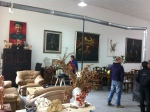
-
Inside the studio of Li Guorui
-
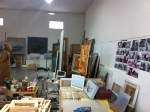
-
Inside the studo of Li Guori
-
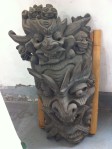
-
Inside the studio of Li Guori
-

-
A sculpture by Li Guorui
-

-
A sculpture by Li Guorui
-
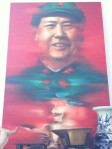
-
Painting of Mao Zedung, the studio of Li Guorui
-

-
Paintings of boats by Li Guorui
-
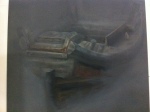
-
Painting by Li Guorui
-

-
Watercolor by Li Guorui
-

-
Painting by Li Guorui
-

-
Lunch
-
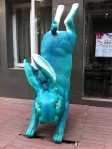
-
Public sculpture, 798 Art District
-

-
Sculpture/painting, 798 Art District
-

-
Painting, 798 Art District
-

-
Painting, 798 Art District
-

-
Painting/sculpture, 798 Art District
-

-
Sculpture of three singing dragons, 798 Art District
-
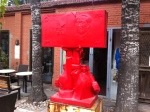
-
Public sculpture, 798 Art District
-

-
Sculptures, 798 Art District
-

-
Public sculpture, 798 Art District
-
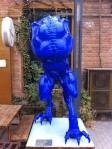
-
Sculpture of an alien, 798 Art District
-

-
Painting, 798 Art District
-

-
Painting, 798 Art District
-
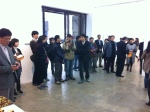
-
Opening of the Gwangju Museum of Art exhibition
-

-
Mr. Hwang Yeong-Seong, the director of the Gwangju Museum of Art, speaking at the opening of the Gwangju Museum of Art exhibition
-

-
At the opening of the Gwangju Museum of Art Beijing artist residency exhibition. Myself pictured front row, fourth from left.
-

-
Dinner for the opening of the Gwangju Museum of Art exhibition





